
Installation instructions and User guide
Ceramic glass cooktops
CE302C, CE604L, CE604C and CE905C models
NZ AU GB IE

Installation instructions and User guide
Ceramic glass cooktops
CE302C, CE604L, CE604C and CE905C models
NZ AU GB IE
Important!
SAVE THESE INSTRUCTIONS
The models shown in this user guide may not be available in all markets and are subject to change at any time. For current details about model and specification availability in your country, please visit our local website listed on the back cover or contact your local Fisher & Paykel dealer.
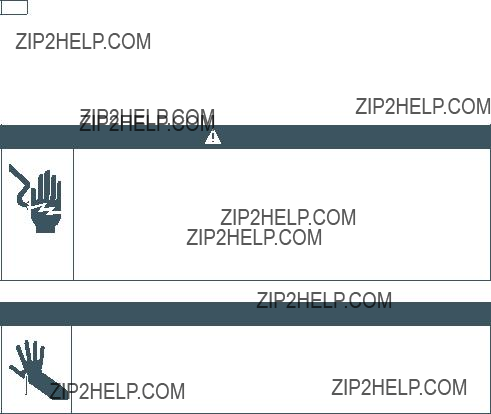
2 Safety and warnings
Your safety is important to us. Please read this information before using your cooktop.
Installation
WARNING!
Electrical Shock Hazard
Disconnect the appliance from the mains electricity supply before carrying out any work or maintenance on it.
Connection to a good earth wiring system is essential and mandatory. Alterations to the domestic wiring system must only be made by a qualified electrician.
Failure to follow this advice may result in electrical shock or death.
 WARNING!
WARNING!
Cut Hazard
Take care ??? panel edges are sharp.
Failure to use caution could result in injury or cuts.

Safety and warnings 3
Important safety instructions
Read these instructions carefully before installing or using this appliance.
No combustible material or products should be placed on this appliance at any time.
Please make this information available to the person responsible for installing the appliance as it could reduce your installation costs.
In order to avoid a hazard, this appliance must be installed according to these instructions for installation.
This appliance is to be properly installed and earthed only by a suitably qualified person.
This appliance should be connected to a circuit which incorporates an isolating switch providing full disconnection from the power supply.
Failure to install the appliance correctly could invalidate any warranty or liability claims.

4 Safety and warnings
Operation and maintenance
WARNING!
Electrical Shock Hazard
Do not cook on a broken or cracked cooktop. If the cooktop surface should break or crack, switch the appliance off immediately at the mains power supply (wall switch) and contact a qualified technician.
Switch the cooktop off at the wall before cleaning or maintenance.
Failure to follow this advice may result in electrical shock or death.
 WARNING!
WARNING!
Fire Hazard
Never leave the appliance unattended when in use. Boilover causes smoking and greasy spillovers that may ignite.
Never use your appliance for warming or heating the room.
Failure to follow this advice may result in overheating, burning, and injury.
 WARNING!
WARNING!
Hot Surface Hazard
During use, accessible parts of this appliance will become hot enough to cause burns.
Do not let body, clothing or any item other than suitable cookware contact with the ceramic glass until the surface is cool.
Never leave metal objects on the cooktop as they can become hot very quickly.
Keep children away.
Handles of saucepans may be hot to touch. Check saucepan handles do not overhang other cooking zones that are on. Keep handles out of reach of children.
Failure to follow this advice could result in burns and scalds.
 WARNING!
WARNING!
Cut Hazard
The
Failure to use caution could result in injury or cuts.

Safety and warnings 5
Important safety instructions
Never use your appliance as a work or storage surface.
Never leave any objects or utensils other than suitable cookware on the appliance. Do not allow children to play with the appliance or sit, stand or climb on it.
Do not store items of interest to children in cabinets above the appliance. Children climbing on the cooktop could be seriously injured.
Do not leave children alone or unattended in the area where the appliance is in use.
Children or persons with a disability which limits their ability to use the appliance should have a responsible and competent person to instruct them in its use. The instructor should be satisfied that they can use the appliance without danger to themselves or their surroundings.
Do not repair or replace any part of the appliance unless specifically recommended in the manual. All other servicing should be done by a qualified technician.
Do not use a steam cleaner to clean your cooktop. Do not place or drop heavy objects on your cooktop. Do not stand on your cooktop.
Do not use pans with jagged edges or drag pans across the ceramic glass surface as this can scratch the glass.
Do not use scourers or any other harsh/abrasive cleaning agents to clean your cooktop, as these can scratch the ceramic glass.
If the power supply cable is damaged, it must only be replaced by a qualified technician.
Do not operate your cooktop by means of an external timer or separate
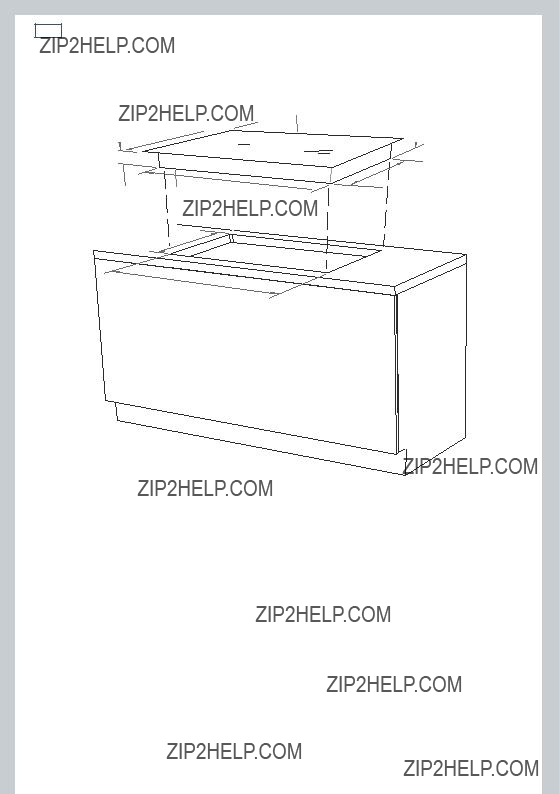
6Installation instructions
Cooktop and cutout dimensions
Drawings for illustration purposes only
1
A
C  B
B 

 CI
CI
E
2 D
 G
G
F
Terminal block location:
1 CE604L, CE604C & CE905C models - Middle rear
2 CE302C models - Front left
Cooktop and cutout dimensions (mm)
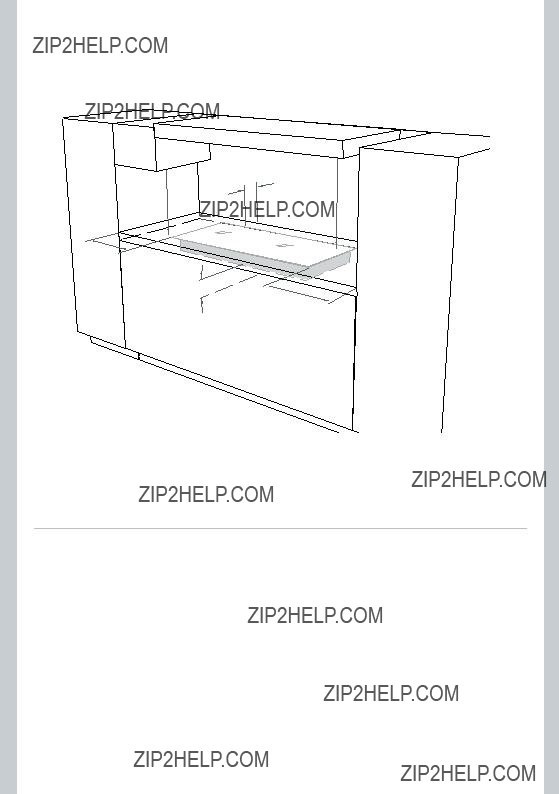
Clearances
Drawings for illustration purposes only
A
D
C
B
C
E
Clearances (mm)
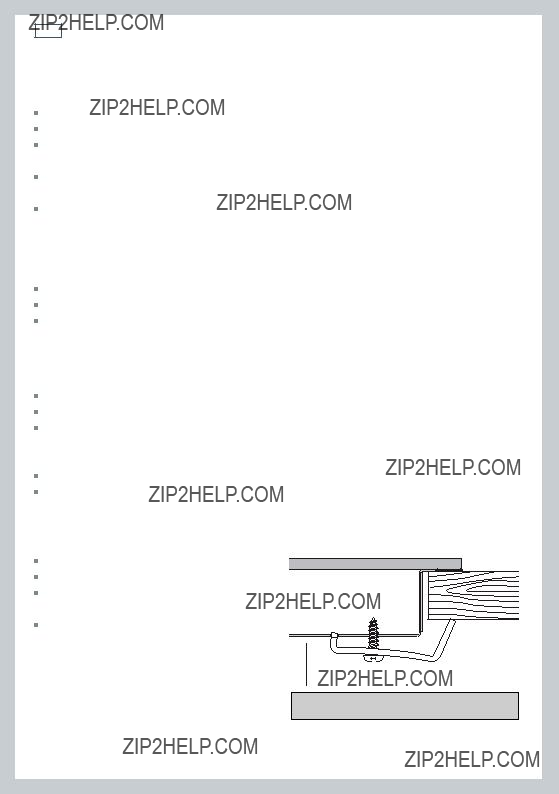
8Installation instructions
Before you install the cooktop, make sure that
the benchtop is square and level, and no structural members interfere with space requirements the benchtop is made of a
the cooktop will not be installed directly above a dishwasher, as the humidity may damage the cooktop
the installation will comply with all clearance requirements and applicable standards and regulations
a suitable isolating switch providing full disconnection from the mains power supply is incorporated in the permanent wiring, mounted and positioned to comply with the local wiring rules and regulations. The isolating switch must be of an approved type and provide a 3 mm air gap contact separation in all poles (or in all active [phase] conductors if the local wiring rules allow for this variation of the requirements)
the isolating switch will be easily accessible to the customer with the cooktop installed you consult local building authorities and
you use
When you have installed the cooktop, make sure that
the power supply cable is not accessible through cupboard doors or drawers
there is adequate flow of fresh air from outside the cabinetry to the base of the cooktop
if the cooktop is installed directly above an oven or its base is accessible through a cupboard or drawer space after installation, a thermal protection barrier is installed below the base of the cooktop (see Fig.1)
the isolating switch is easily accessible by the customer
you complete the ???Final checklist??? at the end of these installation instructions.
The thermal protection barrier must be:
removable
made from low thermal conductivity material
at least 20 mm below the base of the
cooktop to ensure adequate ventilation  min.mm
min.mm
20
< Fresh air from outside the cabinetry
Fig. 1 Thermal protection barrier
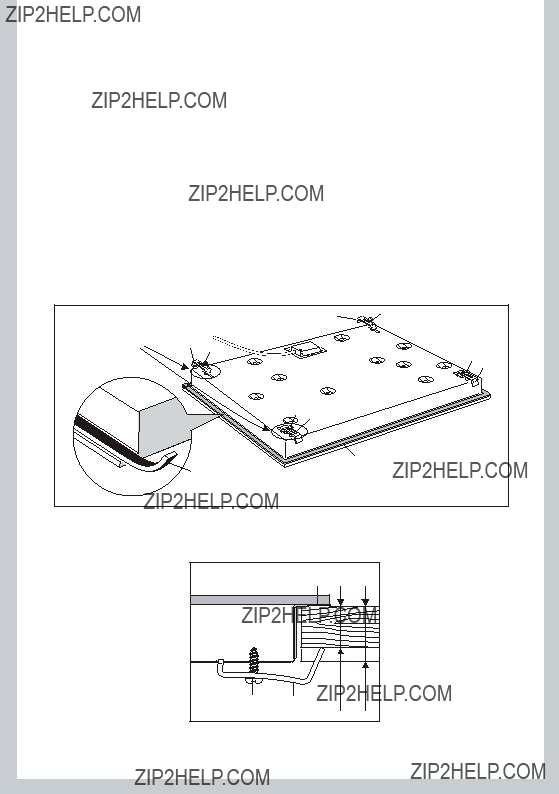
Fastening the cooktop to the bench
1Turn the cooktop upside down and place it on a soft surface.
2Spread the seal around the edges of the ceramic glass with the adhesive side facing down, making sure that the whole perimeter is sealed. Cut off any excess material.
3Mount the supplied clamps (A) and screws (B) onto the cooktop, as shown (without tightening the screws).
4Place the cooktop into the cutout, then tighten the screws to clamp the cooktop securely to the bench.
5Using a sharp cutter or trimmer knife, trim the excess sealing material around the edge of the cooktop. Take care not to damage the benchtop.
Note: if your bench is thicker than 40 mm, recess the underside to between 30 and 40 mm.
Fig. 2 Preparing the cooktop before installation(models may vary)
Fig. 3 Fastening the cooktop to the bench

10 Installation instructions
Connecting the cooktop to the mains power supply
Important!
This cooktop must be connected to the mains power supply only by a suitably qualified person. This cooktop must be earthed.
Before connecting the cooktop to the mains power supply, check that:
1 the domestic wiring system is suitable for the power drawn by the cooktop
2the voltage corresponds to the value given on the rating plate
3the power supply cable sections can withstand the load specified on the rating plate.
To connect the cooktop to the mains power supply, do not use adapters, reducers, or branching devices, as they can cause overheating and fire.
The power supply cable must not touch any hot parts and must be positioned so that its temperature will not exceed 75oC at any point.
Power supply
CE302C 2900W @
CE604L 6000W @
CE604C 6400W @
CE905C 8400W @
Important!
Check with an electrician whether the domestic wiring system is suitable without alterations. Any alterations must only be made by a qualified electrician.
Connection diagrams
CE302C

Installation instructions 11
Final checklist
TO BE COMPLETED BY THE INSTALLER
Is the cooktop earthed?
Check that the power supply cable is NOT touching the base of the cooktop. This will ensure that the cable is not damaged by heat from the cooktop.
Check that the power supply cable is not accessible via cupboard doors or drawers. Is the cooktop clamped down securely?
Check that all the cooking zones function correctly. Turn on all of them to a high setting and leave them on for at least one minute.
Are all elements glowing?
Are all ???Hot surface??? indicators glowing?
Have you shown the customer how to use the cooktop? Make sure you explain to the customer about the ???Hot surface??? indicators. Encourage them to read the full user guide before using the cooktop.
Installer???s name:
Installer???s signature:
Installation company:
Date of installation:
LEAVE THESE INSTRUCTIONS WITH THE CUSTOMER
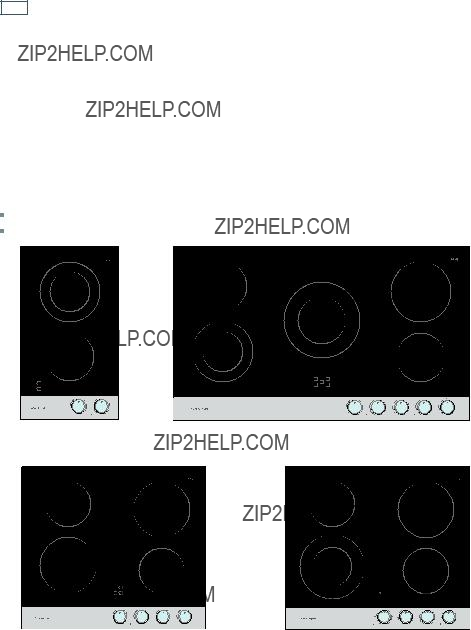
12 Introduction
About your new cooktop
Thank you for buying a Fisher & Paykel ceramic glass cooktop. This guide introduces you to all its special features. We recommend you read the whole guide before using your new cooktop, for both safety and cooking success.
For more information, visit our local website listed on the back cover.
Before using your new cooktop
Read this user guide, taking special note of the ???Safety and warnings??? section. Remove any protective film that may still be on your cooktop.
1
1
4
5
Fig.6 CE604L model
5
Fig.7 CE604C model
1 Single cooking zone
2Dual cooking zone
3 Cooking zone with SuperSimmer feature
4 ???Hot surface??? indicators
5Control dials
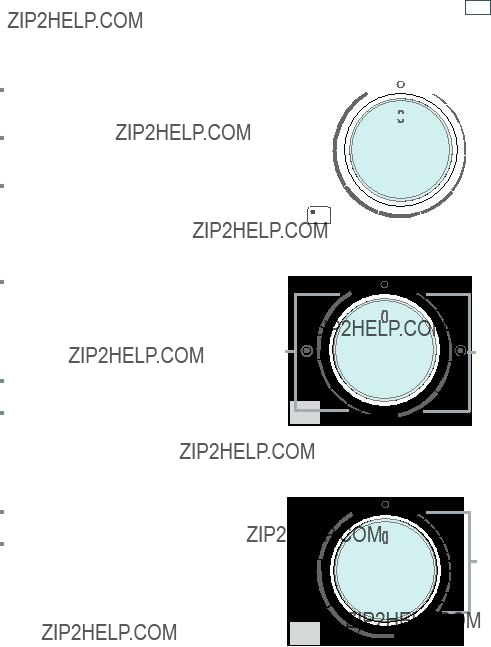
To start cooking
Turn the control dial of the cooking zone you wish to use to the High setting, then adjust as necessary.
When using dual cooking zones, you may choose to use the inner zone only ( ) or the full dual cooking zone (
) or the full dual cooking zone ( ). See Fig. 9 below. Some models have a cooking zone with a unique SuperSimmer feature (see Fig. 10). This special, low turndown range is excellent for the most delicate cooking tasks, like melting chocolate or simmering soups and stews.
). See Fig. 9 below. Some models have a cooking zone with a unique SuperSimmer feature (see Fig. 10). This special, low turndown range is excellent for the most delicate cooking tasks, like melting chocolate or simmering soups and stews.
For further advice on cooking and using the SuperSimmer feature, see ???Cooking guidelines??? following.
???Hot surface??? indicators
As soon as you turn a cooking zone on, its ???Hot surface??? indicator will start glowing.
It will continue to glow even after you have turned the cooking zone off, until the glass becomes cool enough to be safely touched.
When you have finished cooking
When you have finished using a cooking zone, turn its dial to the off (O) position. When you have finished using your cooktop, check that all dials are turned off.
Using your cooktop 13
Fig.8 Single cooking zone control
 Medium
Medium
Fig.10 Cooking zone with SuperSimmer (some models only)
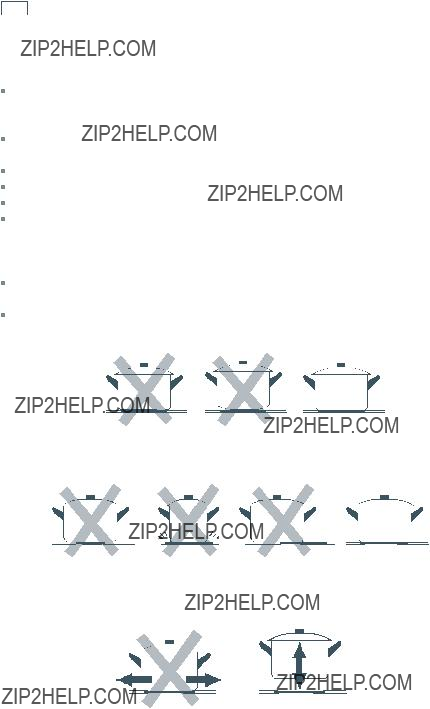
14 Cooking guidelines
Cookware
Use
Cookware with a stainless steel sandwich base or enamelled cast iron will give you the best results.
Saucepans or heavy frying pans with jagged edges or a rough base will scratch the glass. Always lift pans off the cooktop - do not slide, or they may scratch the glass.
Never use plastic or aluminium foil dishes on the cooktop.
Aluminium and
It is safe to place hot cookware from the oven, or another cooking zone, on the glass surface when the surface is cool.
Avoid placing anything on a hot cooking zone until it has cooled completely.

Cooking guidelines 15
Important!
Never leave the appliance unattended when in use. Boilover causes smoking and greasy spillovers that may ignite.
Take care when
General cooking tips
Using a lid will reduce cooking times through retaining the heat. Minimise the amount of liquid or fat to reduce cooking times.
Start cooking on a high setting and reduce it when the food has come to the boil or heated through.
Even after a cooking zone has been turned off, its glass surface retains enough heat to continue cooking. To avoid overcooking, remove pans from hot cooking zones when the food is cooked.
Cooking rice, simmering
Some tasks, including cooking rice by the absorption method, may require a setting higher than the lowest setting to ensure the food is cooked properly in the time recommended.
Simmering occurs below boiling point, when bubbles are just rising occasionally to the surface of the cooking liquid. It???s the key to delicious soups and tender stews because the flavours develop without overcooking the food.
Using the SuperSimmer feature (some models only)
The front right cooking zone on some models has a unique SuperSimmer feature. This allows the cooking zone to be turned down to very low and even heat settings. These are ideal for melting chocolate and butter, cooking rice and delicate sauces, simmering soups and stews, and keeping cooked food hot.
The high settings of the SuperSimmer cooking zone are just as powerful as those of the other cooking zones, allowing food to be browned, seared, saut??ed, or boiled before simmering, all on the same cooking zones.
Searing steak
1 Stand the meat at room temperature for about 20 minutes before cooking.
2Heat up a
3 Brush both sides of the steak with oil and season it to taste.
4Lower the meat onto the hot pan.
5Turn the steak only once during cooking. The exact cooking time will depend on the thickness of the steak and how cooked you want it. Times vary between 2 to 8 minutes per side. Press the steak to gauge how cooked it is: the firmer it feels, the more ???well done??? it will be.
6Leave the steak to rest on a warm plate for a few minutes to allow it to relax and become tender before serving.

16 Care and cleaning
Important!
For your safety, switch the power to the cooktop off at the wall before any cleaning. In this case, there will be no ???Hot surface??? indication, but the cooking zones may still be hot! Take extreme care.
Do not use a steam cleaner to clean your cooktop.
Do not use scourers or any harsh/abrasive cleaning agents to clean your cooktop, as these can scratch the ceramic glass or stainless steel.
soiling examples
Light soiling on glass after every use
fingerprints and marks
stains left by
1Wipe with a soft, damp cloth and
mild detergent. A microfibre or ???glass??? cloth is ideal for this.
2Wipe dry with a clean cloth or paper towel.
Before cleaning, make sure that the glass is a safe temperature to touch.
pasta water, milk, soup
1Remove the soiling with ceramic cooktop cleaner using a sponge or
ceramic glass.
2Remove any excess cleaner and wipe dry with a clean cloth or
paper towel.
3Apply ceramic cooktop conditioner or protector following the instructions on the dispenser. A microfibre or ???glass??? cloth is ideal for this.

Care and cleaning 17
soiling examples
Hot sugary spills, melted plastic or metal on glass
sugar, sugary syrups
jams and jellies vegetables or vegetable water
with high sugar content (peas,
sweetcorn,
beetroot) melted aluminium foil or plastic wrap
Remove these immediately with a spatula or razor blade scraper suitable for ceramic glass cooktops, but beware of hot spills and surfaces:
1Hold the blade or utensil at a 30o
angle and scrape the soiling or spill to a cool area of the cooktop.
2Immediately clean the soiling up with a dish cloth or paper towel.
3Follow the instructions for ???Light soiling on glass after every use??? above.
Remove stains left by melts and sugary food or spillovers immediately. If left to cool on the glass, they may be difficult to remove or even permanently damage the glass surface.
Cut hazard: the blade in a scraper is
Control dials
food stains fingerprints and marks
1Wipe with a damp cloth and mild detergent.
2Dry thoroughly with a soft cloth.
Do not use stainless steel cleaner on the dials, as doing so may damage their coating.

18 Troubleshooting
Troubleshooting chart

Warranty and service 19
Before you call for service or assistance ...
Check the things you can do yourself. Refer to the installation instructions and your user guide and check that:
1your product is correctly installed
2you are familiar with its normal operation.
If after checking these points you still need assistance or parts, please refer to the Service & Warranty book for warranty details and your nearest Authorised Repairer, Customer Care, or contact us through our local website listed on the back cover.

20 Warranty and service
This cooktop has been designed and constructed in accordance with the following codes and specifications:
In New Zealand and Australia:
AS/NZS
AS/NZS
In Europe:
Safety requirements of EEC Directive ???Low voltage??? 2006/95:
-EN
-EN
-EN
Requirements of EEC Directive 93/68.
European directive 2002/96/EC on Waste Electrical and Electronic Equipment (WEEE) (for European Union countries only)
GB This appliance is marked according to the European directive 2002/96/EC on Waste Electrical and Electronic Equipment (WEEE). By ensuring this product is disposed of correctly, you will help prevent potential negative consequences for the environment and human health, which could otherwise be caused by inappropriate waste handling of this product.
The symbol  on the product, or on the documents accompanying the product, indicates that this appliance may not be treated as household waste. Instead it shall be handed over to the applicable collection point for the recycling of electrical and electronic equipment. Disposal must be carried out in accordance with local environmental regulations for waste disposal.
on the product, or on the documents accompanying the product, indicates that this appliance may not be treated as household waste. Instead it shall be handed over to the applicable collection point for the recycling of electrical and electronic equipment. Disposal must be carried out in accordance with local environmental regulations for waste disposal.
For more detailed information about treatment, recovery and recycling of this product, please contact your local city office, your household waste disposal service or the shop where you purchased the product.
Product details
Fisher & Paykel Ltd

Copyright ?? Fisher & Paykel 2009. All rights reserved.
The product specifications in this booklet apply to the specific products and models described at the date of issue. Under our policy of continuous product improvement, these specifications may change at any time. You should therefore check with your Dealer to ensure this booklet correctly describes the product currently available.
www.fisherpaykel.co.nz
www.fisherpaykel.com.au
www.fisherpaykel.co.uk
www.fisherpaykel.ie
NZ AU GB IE
Ceramic glass cooktop user guide
Published: 06/2009
Part No. 599578 A
F&P Italy Part No. 1103327 - ??1